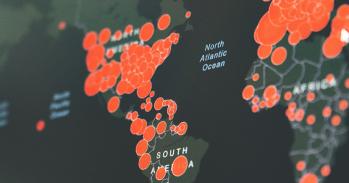
As our ability to assess the pandemic risk from strains of influenza virus increases with the latest scientific developments, we must not allow ourselves to become complacent that the most substantial threats have been identified, argue an international consortium of scientists.
As our ability to assess the pandemic risk from strains of influenza virus increases with the latest scientific developments, we must not allow ourselves to become complacent that the most substantial threats have been identified, argue an international consortium of scientists.
We are getting much better at identifying and assessing potential threats, but we must be vigilant about surprises lurking around the corner
Colin Russell
Influenza pandemics arise when a new virus strain – against which humans have yet to develop widespread immunity – spreads in the human population. There have been five such pandemics in the past 100 years, the worst of which – the 1918 Spanish Flu – cost 50 million lives worldwide. Of these pandemics, three are thought to have spread from birds and one from pigs. However, pandemic influenza strains represent only a tiny fraction of the total diversity of influenza viruses that exist in nature; the threats posed by the majority of these viruses are poorly understood. Assessing which viruses pose the greatest risk of causing the next human pandemic is an enormous challenge.
Steven Riley from Imperial College London, an author of the study, says: “There are too many strains of influenza viruses out there in non-human hosts to make it feasible to make preparations against each one. Instead, we need to get better at assessing the pandemic risks so that we know where best to focus our efforts. At the moment, this assessment is largely driven by a simple idea: animal viruses that cause sporadic human infections pose a greater risk than viruses that have not been documented to infect humans. But in fact, none of the viruses that caused the major pandemics of the last century were detected in humans before they emerged in their pandemic form.”
Writing in the journal eLife, the scientists set out the steps that they consider necessary to increase our ability to assess pandemic risk. As influenza virus genome sequencing becomes cheaper, faster and more readily available, the data it generates has the potential to transform the research community’s ability to predict the pandemic risk. However, it remains extremely difficult to predict just from a virus’s genome what symptoms it will elicit in its host – and hence how deadly the virus is. The researchers call for better integration of experimental data, computational methods and mathematical models, in conjunction with refinements to surveillance methodology.
However, they say that scientific insights into non‐human influenza viruses must not give way to complacency that the most substantial threats have been identified and characterized. They point out that several recent strains including the 2009 H1N1 “swine flu” pandemic virus and the recently emerged H7N9 viruses in China highlight the importance of remaining vigilant against as-yet unrecognized high risk viruses and the value of surveillance for influenza viruses in humans.
“No one can say with anything close to a hundred percent certainty when or where the next pandemic will start or which virus will cause it,” says Dr Colin Russell from the Department of Veterinary Medicine at the University of Cambridge. “We are getting much better at identifying and assessing potential threats, but we must be vigilant about surprises lurking around the corner.
“We need to be prepared for a swift response, with coordinated action, to help mitigate the spread of the next pandemic virus. Without developing this ability to respond, we will have spent billions building systems just for watching the next pandemic unfold.”
The research was supported in part by the Research and Policy for Infectious Disease Dynamics program of the US Department of Homeland Security and the National Institutes of Health.
Reference
Russell, CA et al. Improving pandemic influenza risk assessment. eLife; 15 Oct 2015
The text in this work is licensed under a Creative Commons Licence. If you use this content on your site please link back to this page. For image rights, please see the credits associated with each individual image.





